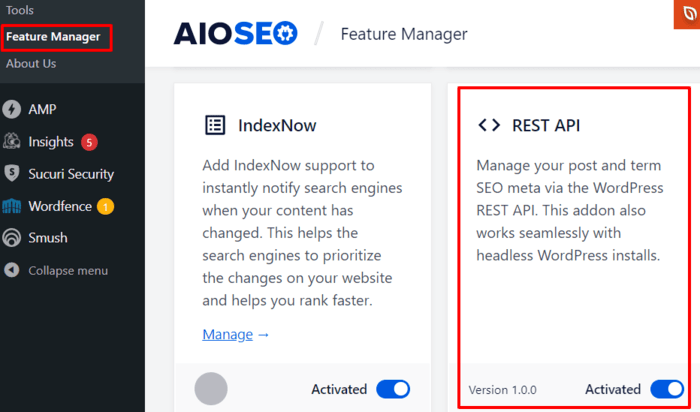What is the WordPress REST API, and what does it have to do with SEO?
WordPress REST API has been a part of WordPress core since 2015. But it’s only in recent years that it has come into its own and became the next game-changer for WordPress websites. Sadly, however, this powerful WordPress feature has only been used by advanced users because of its complexity.
We’ve incorporated WordPress REST API into our plugin to make it easier for beginners.
What is the WordPress REST API?
To better grasp the SEO possibilities of the WordPress REST API, let’s quickly look at it.
First, you need to know that the phrase “REST API” comes from two acronyms. Here’s what they stand for:
What is an API?
An application programming interface (API) is software that enables two applications to communicate with each other. APIs are very common and are used in many applications. For example, when you open Facebook on your phone, a request is sent to the Facebook servers, which is met by a response sent back to your phone. It’s more complicated than that. That’s the diluted version. However, the communication between Facebook and your phone is facilitated by APIs.
What is REST?
REST stands for representational state transfer. It’s a standardized format designed to help web systems interface and communicate with each other. The five principles that govern this standardization include:
- Uniform Interface: All application requests and responses must follow a standard protocol. This is usually the Hypertext Transfer Protocol (HTTP) which is used to communicate over the internet.
- Client-Server: The host server and the application using the API (“client”) must be kept as separate systems. This allows them to be developed separately. Communication is facilitated when the client makes a request and the server responds.
- Stateless: All interactions with an API should be independent of each other. Each request and response must contain the required information to complete the exchange. As such, requests and references made are never referenced.
- Cacheable: All resources shared must be cacheable. When a client requests resources (data) from the server, the server must indicate whether said resources may be cached by the client and for how long. This helps improve speed and is in compliance with internet standards.
- Layered System: Clients and servers rarely connect directly over a network. Proxy servers are usually used to handle traffic, performance, and security. A RESTful system, therefore, allows you to use multiple layers. It also sorts out data in the proxy servers if needed.
These five principles standardize how web applications communicate. They ensure that all communication via the REST API follows the same processes. More importantly, they ensure that the two applications remain independent. Doing so ensures that a change in one application does not affect the communication between the two.
What Does REST API Mean for WordPress?
For WordPress users, REST API opens up a host of possibilities. That’s because it enables other systems to interface with WordPress easily. The implications are that third-party websites or mobile apps can fetch and manipulate your WordPress data.
One of the most significant uses of REST API is that it allows developers to build websites powered by WordPress without building the frontend with it. In other words, they can harness the database, article drafting functionalities, and other features in the backend while developing the frontend of the website using a completely different framework.
This is known as a headless WordPress site.
SEO: One of the Biggest Challenges Solved By WordPress REST API
Headless WordPress gives you the ability to take advantage of the power of WordPress on the backend and use modern technologies on the frontend. While this makes for a powerful and beautiful website, there’s one major caveat — it complicates SEO.
The main reason is that you can only implement most WordPress SEO practices on the backend.
But with AIOSEO’s REST API addon, that is a problem of the past. This new addon plugin integrates with the WordPress REST API to support headless CMS installations. AIOSEO is a powerful WordPress SEO plugin that helps non-techy users handle most SEO needs without hiring an expert. With the REST API addon, you can now manage your headless WordPress site’s SEO. To get started, head over to the Feature Manager section of the AIOSEO dashboard:

Activate the REST API addon, and it will enable you to pull SEO data from the backend of your site and implement it on the frontend. This includes, among other things:
- SEO title
- Meta description
- Robots meta tag
- Canonical URL
- JSON Schema markup
- Open Graph metadata
With the REST API addon active, you can fetch your SEO data via the WordPress REST API for any post or term. In addition, AIOSEO will automatically return all meta tags and values that it would normally output in the source so that you can implement them on the frontend of your site.
WordPress REST API Addon: Giving You More Control Over Your Headless Site’s SEO
AIOSEO’s REST API addon is a game-changer for Headless WordPress SEO. Because it enables you to pull metadata from the backend of your website and implement it on the frontend, taking control of your SEO becomes easier.
If you haven’t downloaded AIOSEO yet, there’s no better time than now. So, get yourself the best WordPress SEO plugin on the market.
Disclosure: Our content is reader-supported. This means if you click on some of our links, then we may earn a commission. We only recommend products that we believe will add value to our readers.

